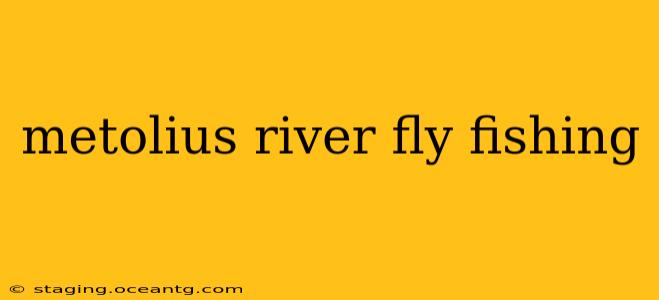The Metolius River in Oregon is a fly fishing paradise, renowned for its pristine waters, abundant fish populations, and stunning natural beauty. This comprehensive guide delves into everything you need to know to plan a successful and memorable fishing trip on this iconic river. From understanding the best times to fish to mastering the techniques, we'll cover it all.
What Makes the Metolius River So Special for Fly Fishing?
The Metolius River distinguishes itself through its unique characteristics. Its remarkably clear, spring-fed waters maintain a consistent temperature throughout the year, creating an ideal habitat for trout. This consistent water temperature, coupled with a diverse insect population, ensures year-round fishing opportunities, though the best times vary depending on your target species and preferred fishing style. The river's relatively consistent flow also makes it a predictable and enjoyable fishing experience, unlike many rivers prone to dramatic fluctuations. The Metolius also boasts a remarkable lack of development along much of its course, preserving its wild and scenic character.
What are the Best Times of Year to Fly Fish the Metolius River?
This depends largely on your target species and preferred fishing method.
Spring (April-May):
Spring offers excellent opportunities for targeting emerging caddisflies and other early season insects. The water is generally still quite cold, so nymphing is often the most productive technique.
Summer (June-August):
Summer brings warmer water temperatures and increased insect activity. Dry fly fishing becomes highly effective, with numerous terrestrial insects and emerging mayflies providing ample food for the trout.
Fall (September-October):
Fall offers another period of excellent dry fly fishing, as salmonflies and other insects continue to be active. The water starts to cool, providing comfortable conditions for anglers.
Winter (November-March):
While fishing is possible year-round, winter conditions can be challenging. The water is very cold, and access to some areas may be limited by snow or ice. Nymphing remains a viable technique, though fishing success may be more dependent on locating fish in deeper, slower sections of the river.
What Kinds of Fish Can I Catch in the Metolius River?
The Metolius River is primarily known for its robust population of rainbow trout, many of which are sizable and incredibly strong fighters. You will also find bull trout, a native species that is highly prized by anglers. While less common, brown trout can also be found in certain sections of the river.
What are the Best Flies to Use on the Metolius River?
The best flies to use will depend on the time of year and the specific insects hatching. However, some consistently productive patterns include:
- Caddisflies: Various caddis patterns, including emergers, pupae, and adults, are effective year-round.
- Mayflies: Different mayfly nymphs and dry flies are essential for spring and summer fishing.
- Stoneflies: Stonefly nymphs are a staple in the Metolius's diet.
- Terrestrials: Ants, beetles, and grasshoppers become increasingly important during the summer months.
What are the Regulations and Access for Fly Fishing the Metolius River?
It’s crucial to check the Oregon Department of Fish and Wildlife (ODFW) website for the most up-to-date regulations, including license requirements, catch limits, and any special regulations that may apply to specific areas of the river. Access to the Metolius River varies along its length; some areas have readily accessible public access points, while others may require hiking or wading through more challenging terrain. Always practice Leave No Trace principles and respect private property.
What Gear Do I Need for Fly Fishing the Metolius River?
Standard fly fishing gear is suitable, although a 5-weight or 6-weight fly rod is generally recommended for handling the size and strength of the trout. Waders are essential, as wading is often necessary to reach productive fishing spots. Polarized sunglasses are highly recommended for spotting fish in the clear water. A net with a rubberized mesh is crucial to protect the fish.
Where are the Best Places to Access the Metolius River for Fly Fishing?
Numerous public access points exist along the Metolius River, but researching specific locations before your trip is highly recommended. Local fly shops and fishing guides can provide valuable information on access points and fishing conditions.
This guide provides a foundational understanding of fly fishing the Metolius River. Remember, responsible angling practices, thorough preparation, and respect for the environment are crucial for ensuring the longevity of this incredible fishing resource. Happy fishing!
